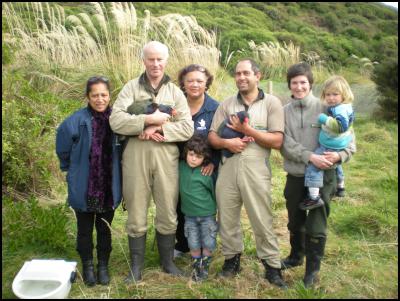Mana Island takahë on the move
Date: 29 August 2011
Mana Island takahë on the move

Last week two endangered takahë, members of Mana Island's successful breeding population, said farewell to the region and headed north to help start a new population on Auckland's Motutapu Island.
Thanks to sponsorship from Mitre 10 Takahë Rescue, the Department of Conservation moved the two takahë to recently declared predator free Motutapu Island in the Hauraki Gulf Marine Park. The move marks the first of what is hoped to be a ten-year translocation programme to help increase the total number of takahë in New Zealand and reduce the risk of the species becoming extinct.
"This is a proud moment for us" says the Department's Mana Island Ranger Sue Caldwell.
"We've worked really hard over the years to protect this endangered bird, providing a safe and suitable habitat for population growth. Now that the population has reached maximum numbers for our little island, it’s great to find a new home for the birds where our breeding success story can continue."
A total of six takahë were originally introduced to Mana Island in 1987 and 1988. Currently, a total of 36 takahë reside on Mana Island.
"To have reached such significant numbers on Mana illustrates the enormous success of DOC's breeding programme” says Caldwell. "Offshore islands offer an important tool in the Department's recovery efforts for this native bird - an insurance policy if you like. We’re enormously grateful to Mitre 10 Takahë Rescue for their support in helping us achieve this success."
A special karakia by Ngati Toa kaumatua was held to mark the departure of the birds from the island on 24 August. Tangata whenua travelled to Motutapu Island for the weekend celebration on 27 August, welcoming the birds to their new home and to wish them well as they embark on their new adventure.
Takahë, a ground dwelling bird that looks like a chunky version of a pukeko, are one of the world's rarest birds. They were once thought to be extinct, following intensive hunting, predation from introduced pests and habitat loss, but were rediscovered in 1948 in a remote Fiordland valley. Thanks to the Department of Conservation's intensive recovery programme, comprising captive breeding, pest control and translocations to pest free islands, takahë have increased from a low of 112 birds in 1981 to the current population of 250 birds.
ends


 Gordon Campbell: On Abortion’s Role In The US Election
Gordon Campbell: On Abortion’s Role In The US Election NZ Labour Party: Labour, Greens And Te Pāti Māori Call On The Prime Minister To Block The Treaty Principles Bill
NZ Labour Party: Labour, Greens And Te Pāti Māori Call On The Prime Minister To Block The Treaty Principles Bill NZ Taxpayers' Union: Has Simon Watts Forgotten Who The Minister Is?
NZ Taxpayers' Union: Has Simon Watts Forgotten Who The Minister Is? Department of Conservation: Priority Conservation Projects Open For Donations
Department of Conservation: Priority Conservation Projects Open For Donations NZ Labour Party: Winston Peters Must Apologise
NZ Labour Party: Winston Peters Must Apologise Meat The Need: National Charity Auction To Combat Food Insecurity In New Zealand
Meat The Need: National Charity Auction To Combat Food Insecurity In New Zealand Inland Revenue Department: Inland Revenue Stops Using Custom Audience Lists
Inland Revenue Department: Inland Revenue Stops Using Custom Audience Lists


